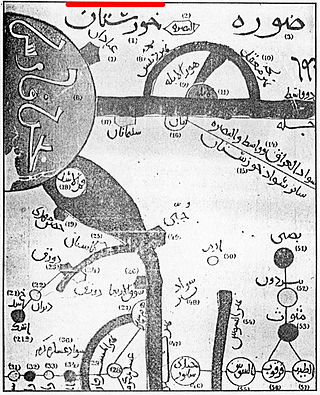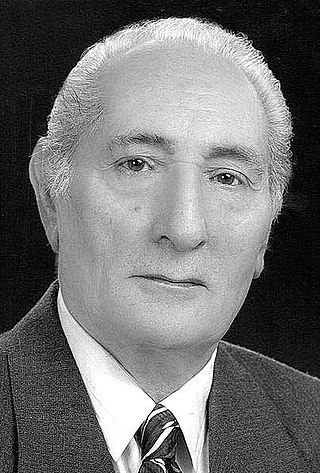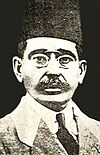
Jalāl al-Dīn Muḥammad Rūmī, or simply Rumi, was a 13th-century poet, Hanafi faqih, Islamic scholar, Maturidi theologian and Sufi mystic originally from Greater Khorasan in Greater Iran.

The Academy of Persian Language and Literature (APLL) is the regulatory body for the Persian language, headquartered in Tehran, Iran. Formerly known as the Academy of Iran, it was founded on May 20, 1935, by the initiative of Reza Shah, the founder of Pahlavi dynasty.

Mohammad-Taqi Bahar, widely known as Malek osh-Sho'arā and Malek osh-Sho'arā Bahār, was a renowned Iranian poet, scholar, politician, journalist, historian and Professor of Literature. Although he was a 20th-century poet, his poems are fairly traditional and strongly nationalistic in character. Bahar was father of prominent Iranist, linguist, mythologist and Persian historian Mehrdad Bahar.

The Shāh Abdol-Azīm Shrine, also known as Shabdolazim, located in Rey, Iran, contains the tomb of ‘Abdul ‘Adhīm ibn ‘Abdillāh al-Hasanī. Shah Abdol Azim was a fifth generation descendant of Hasan ibn ‘Alī and a companion of Muhammad al-Taqī. He was entombed here after his death in the 9th century.

Although Herodotus and Xenophon referred to the entire region as Susiana, the name Khuzestan is what has been referred to the southwesternmost province of Persia (Iran) from antiquity.

An Iranian architect is traditionally called a mi'mar.
In Shi'a Islam the guidance of clergy and keeping such a structure holds great importance. There are several branches of Shi'ism, of which Twelver Shi'ism is by far the largest, and each of the branches has different clergy structures. Individual clerics are referred to as mullā or ākhūnd, but since those terms have developed "a somewhat pejorative connotation" since at least the 1980s, the term rūḥānī has been "promoted" as an alternative, "especially by the clerical class itself".

Badiozzaman Forouzanfar or Badi'ozzamān Forūzānfar was a scholar of Persian literature, Iranian linguistics and culture, and an expert on Rumi and his works. He was a distinguished professor of literature at Tehran University.

Mirzā Jahāngir Khān, also known as Mirzā Jahāngir Khān Shirāzi and Jahāngir-Khān-e Sūr-e-Esrāfil, was an Iranian writer and intellectual, and a revolutionary during the Iranian Constitutional Revolution (1905–1911). He is best known for his editorship of the progressive weekly newspaper Sur-e Esrāfil, of which he was also the founder. He was executed, at the age of 38, or 32, for his revolutionary zeal, following the successful coup d'état of Mohammad-Ali Shah Qajar in June 1908. His execution took place in Bāgh-e Shāh in Tehran, and was attended by Mohammad-Ali Shah himself. He shared this fate simultaneously with his fellow revolutionary Mirzā Nasro'llah Beheshti, better known as Malek al-Motakallemin. It has been reported that immediately before his execution he had said "Long live the constitutional government" and pointed to the ground and uttered the words "O Land, we are [being] killed for the sake of your preservation [/protection]".
Saib Tabrizi was an Iranian poet, regarded as one of the greatest masters of a form of classical Persian lyric poetry characterized by rhymed couplets, known as the ghazal. He also established the "Indian style" in the literature of his native language, Azerbaijani Turkic, in which he is known to have written 17 ghazals and molammaʿs.

Mohammad-Amin Riahi was a prominent Iranian literary scholar of Persian literature, a historian, writer and statesman. Apart from being one of the authors of Dehkhoda Dictionary and Encyclopædia Iranica, he was the author and editor of several well-known scholarly books. Mohammad-Amin Riahi received his PHD on Persian literature from Tehran University under the supervision of Badiozzaman Forouzanfar. Riahi is best known for his scholarly works on Shahnameh and Ferdowsi, Hafiz, and the ancient iranian languages. He has produced critical editions of some of the major classical Persian texts such as Mersad-al-ebad and Nozhat-al-majalis. During a course of 60 years he published numerous scholarly articles, a selection of which are gathered in a volume titled Forty essays on language, literature and history of Iran.

Mirza Seyyed Mohammad Tabatabai was one of the leaders of the Iranian Constitutional Revolution who played an important role in the establishment of democracy and rule of law in Iran. He was the son of Sayyed Sādegh Tabātabā'i, one of the influential Scholar during the reign of Naser ad-Din Shah Qajar. His paternal grandfather, Sayyed Mehdi Tabātabā'i, was a reputed clergy in Hamedan. He is the father of Sayyed Sādegh Tabātabā'i editor of Ruznāmeh-ye Majles, the Majles newspaper.

Mohammad Taqi Amoli (1887—1971) was an Iranian Shia jurist, philosopher and mystic.

Mirza Jalal Mohammad, who is best known as Asir-e Esfahani (Asir) and Shahrestani, was a poet in 17th-century Safavid Iran. He was an innovative writer whose oeuvre contains examples of all conventional Persian poetic forms, a grandee at court and a son-in-law of Shah ("King") Abbas the Great.
















